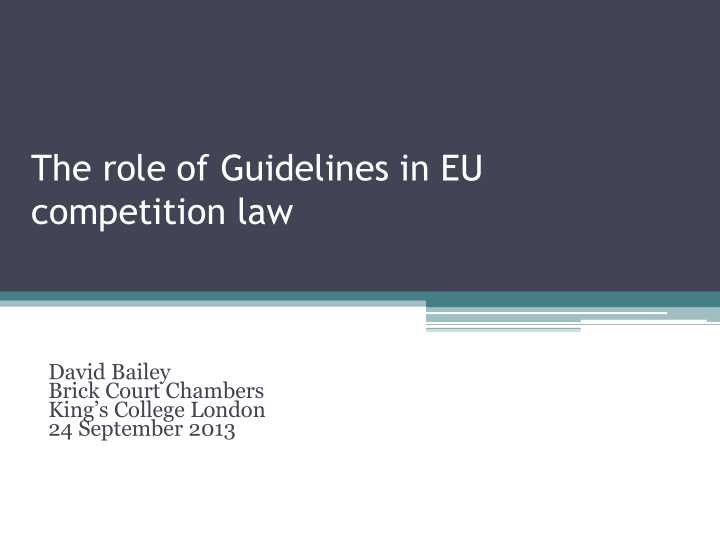



The role of Guidelines in EU competition law David Bailey Brick Court Chambers King’s College London 24 September 2013
Outline of presentation • What is a Guideline? • What is the purpose of Guidelines? • What is the legal status of Guidelines? • The future of Guidelines in EU competition law • Conclusion
Guidelines are all around us
Growth in EU Guidelines • Christmas Message of 1962 • De minimis Notices of 1970, 1977, 1986, 1997, 2001, 2013 (draft) • Fining Guidelines of 1996 and 2006 • Market Definition Notice of 1997 • “Modernisation Package” of 2004 • Non-Horizontal Merger Guidelines of 2008 • Article 102 Enforcement Priorities Guidance of 2009
Variety of ‘Guidelines’ • Commission Notices, Communications • Commission Guidance on enforcement priorities • Commission brochures (e.g. compliance) • Annual Reports on Competition Policy • DG COMP publications ▫ Best practices (e.g. merger control) ▫ Discussion paper (e.g. Art 102) ▫ DG COMP Manual of procedure ▫ Explanatory note (e.g. inspections) ▫ Model texts (e.g. commitments)
Importance of Guidelines • Consulting Guidelines is now routine for undertakings and their legal advisers • Growing number of cases challenging the status and the application of Guidelines:- ▫ Case C-52/09 TeliaSonera (2011): Art 102 ▫ Case C-226/11 Expedia (2012): de minimis ▫ Case T-111/08 MasterCard (2012): Art 101(3) ▫ Case C-439/11P Ziegler (2013): effect on trade ▫ Case C-501/11P Schindler (2013) : fines
What is the purpose of Guidelines? • Cases T-148/89 Tréfilunion v Commission (1995), para 142 « the Court considers that ... it is desirable for undertakings in order to be able to define their position in full knowledge of the facts to be able to determine in detail, in accordance with any system which the Commission might consider appropriate, the method of calculation of the fine imposed upon them »
What is the purpose of Guidelines? • Transparency • Accountability • Interpretation/clarification of the law • Legal certainty • Consistency of enforcement • Presumptions/safe harbours • Commission’s approach to unresolved issues • Create legitimate expectations • Create practical mechanisms for co-operation
What is the legal status of a Guideline? • To whom is the Guideline being applied • What does the Guideline say • How is the Guideline being applied (equal treatment and consistency in the present case) • When has this aspect of the Guideline been applied before (consistency over time)
What is the legal status of a Guideline? The legal status of Guidelines varies • European Commission • Court of Justice and General Court • National competition authorities • National courts • Undertakings
Commission and its own Notices • Articles 105 and 292 TFEU: Case C-234/89 Delimitis (1991), para 44 • Article 288(5) TFEU: AG Kokott in Case C-226/11 Expedia (2012), para 30 • Publication in the ‘C’ series of the OJ: Case C-410/09 Polska Telefonia (2011), para 35 • Pay careful attention to the wording of Notices
Commission and its own Notices • Legal effect of Commission Notices « Guidelines are capable of producing legal effects. Those effects stem not from an attribute of the Guidelines as rules of law in themselves, but from their adoption and publication by the Commission » Case T-59/02 Archer Daniels Midland (2006), para 43
Commission Notices and EU Courts • Duty of the EU Courts under Article 19 TEU • Notices have no binding effect on the EU Courts • Notices can be “ a useful point of reference ”: see Case C-310/99 Italy v Commission (2002), para 52 • Informal/indirect influence on the case-law ... “ some things are better left unsaid ”?
Notices and case-law: convergence • As efficient competitor test for pricing abuses ▫ Article 102 Enforcement Priorities Guidance (2009), para 23 ▫ Case C-52/09 TeliaSonera (2011), paras 31 and 63-64 • Market definition ▫ Notice on market definition (1997), paras 13 ff ▫ Case T-321/05 AstraZeneca v Commission ( 2010), paras 30-31 and 86-90
Notices and case-law: convergence • The sobriquet of ‘Article 102(3)’ ▫ Art 102 Enforcement Priorities Guidance (2008), para 30 ▫ Case C-209/10 Post Danmark (2012), para 42 • Subjective intent can be relevant to ‘object’ ▫ Article 101(3) Guidelines (2004), para 21 ▫ Case C-68/11 Allianz (2013), para 37
Notices and case-law: divergence • Application of Article 101(3) to vertical restraints with dominant undertakings ▫ Guidelines on Vertical Restraints (2000), para 135 ▫ Cases T-191/98 TACA (2003), para 1456 • Whether margin squeeze should be understood as a type of refusal to supply under Article 102 ▫ Art 102 Enforcement Priorities Guidance, para 80 ▫ Case C-52/09 TeliaSonera (2011), para 58
Commission Notices and NCAs • Apart from one Notice, no binding legal effect on NCAs ▫ The exception is the Network Notice • NCAs regularly rely on Notices – e.g. OFT no grounds for action decision in IDEXX (2010) • NCAs are consulted on draft/revised Notices
Commission Notices and national courts • No binding legal effect for national courts – e.g. Case C-360/09 Pfleiderer (2011), para 21 • Morgan J in BAGS (2008), paras 303 ff • CAT in Tesco v OFT (2012), para 81 • Paris Court of Appeal in Pierre Fabre (2009)
The future of Guidelines in the EU • Will any Notices be withdrawn? ▫ Maritime guidelines expire in two days’ time! • Will the Commission issue any new Notices? ▫ Undertakings? Wouters ? Single economic entity? • Will the EU Courts expressly acknowledge their agreement with a proposition in a Guideline? • Will the EU Courts expressly disagree with a view or principle contained in a Guideline?
Conclusions • Guidelines are rules of practice, not rules of law • Guidelines can be legally binding, depending on what they say and to whom they are applied • Practical importance of Guidelines: nudge • Watch the impact of international guidelines – e.g. ICN Merger Guidelines Workbook (2006)
Recommend
More recommend